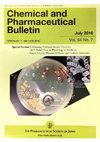增强离子液体中左旋抗坏血酸的物理稳定性
IF 1.5
4区 医学
Q4 CHEMISTRY, MEDICINAL
Chemical & pharmaceutical bulletin
Pub Date : 2024-02-21
Epub Date: 2024-01-26
DOI:10.1248/cpb.c23-00861
引用次数: 0
摘要
离子液体(IL)技术用于提高 L-抗坏血酸(AA)的稳定性。选择吡哆醇作为阴离子 AA 在离子液体中的反阳离子。AA 在 40°C 下溶于水后,7 天后其比例降至 3.2%。相比之下,IL 制剂的降解几乎可以忽略不计,即使在 28 天后 AA 也几乎没有损失。这些结果表明,使用 IL 可以提高 AA 的稳定性。本文章由计算机程序翻译,如有差异,请以英文原文为准。
Enhanced Physical Stability of L-Ascorbic Acid in an Ionic Liquid.
Ionic liquid (IL) technology was used to enhance the stability of L-ascorbic acid (AA). Pyridoxine was selected as the counter cation for anionic AA in IL. After AA was dissolved in water at 40 °C, its ratio decreased to 3.2% after 7 d. In contrast, the IL formulation showed negligible degradation, with almost no loss of AA even after 28 d. These results suggest that the use of IL enhances the stability of AA.
求助全文
通过发布文献求助,成功后即可免费获取论文全文。
去求助
来源期刊
CiteScore
3.20
自引率
5.90%
发文量
132
审稿时长
1.7 months
期刊介绍:
The CPB covers various chemical topics in the pharmaceutical and health sciences fields dealing with biologically active compounds, natural products, and medicines, while BPB deals with a wide range of biological topics in the pharmaceutical and health sciences fields including scientific research from basic to clinical studies. For details of their respective scopes, please refer to the submission topic categories below.
Topics: Organic chemistry
In silico science
Inorganic chemistry
Pharmacognosy
Health statistics
Forensic science
Biochemistry
Pharmacology
Pharmaceutical care and science
Medicinal chemistry
Analytical chemistry
Physical pharmacy
Natural product chemistry
Toxicology
Environmental science
Molecular and cellular biology
Biopharmacy and pharmacokinetics
Pharmaceutical education
Chemical biology
Physical chemistry
Pharmaceutical engineering
Epidemiology
Hygiene
Regulatory science
Immunology and microbiology
Clinical pharmacy
Miscellaneous.

 求助内容:
求助内容: 应助结果提醒方式:
应助结果提醒方式:


